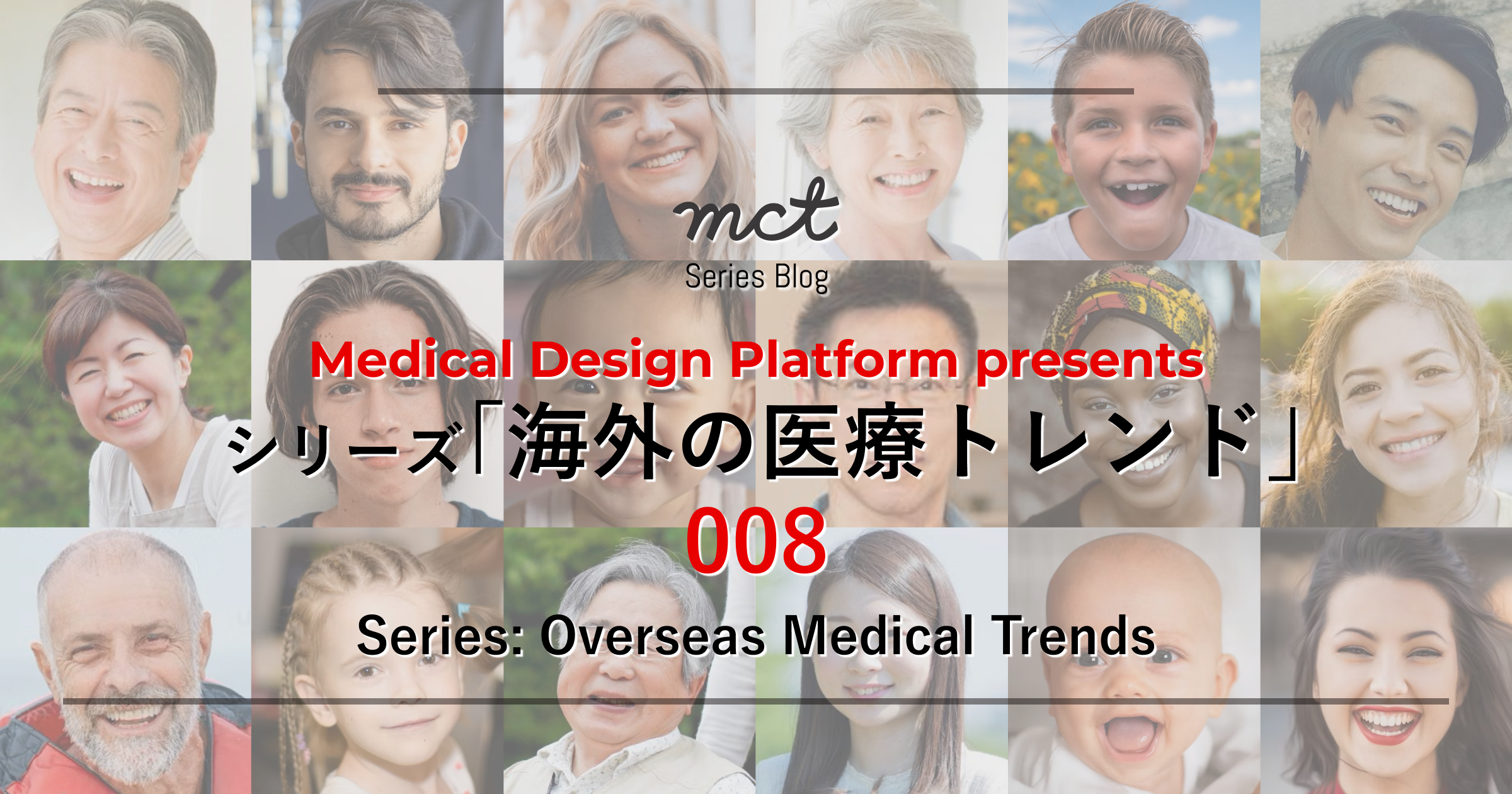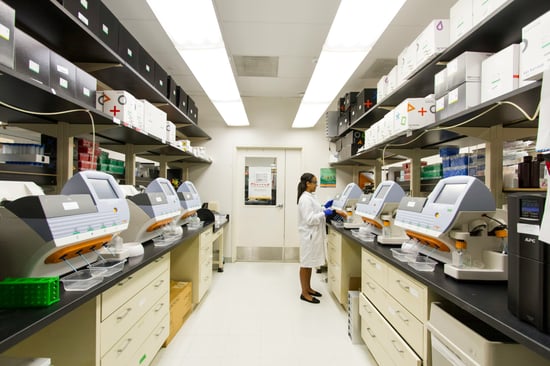2024.08.30
Series Blog|シリーズ 「海外の医療トレンド」 008 Overseas Medical Trends
widw

シリーズ「海外の医療トレンド」は、mctのメディカルデザインプラットフォームがお届けする、
海外の医療情報をテーマとしたシリーズブログです。
今回お届けする「Special Topic」は、
アメリカ在住で、新薬開発の治験支援を行っているシグナントヘルス社の町澤さやか氏に、
アメリカの治験の現状について、さまざまな視点で発信いただくシリーズです。
“Overseas Medical Trends" is a series of blogs on overseas medical information,
brought to you by mct's "Medical Design Platform".
"Special Topic" is a series of articles by Sayaka Machizawa of Signant Health,
a U.S.-based company that supports clinical trials for new drug development, who will provide various
perspectives on the current state of clinical trials in the United States.
「メディカルデザインプラットフォーム」は、顧客視点でビジネスの問題解決をお手伝いしている
株式会社mctの「患者さん中心の医療」に関わる情報やサービスを提供するユニットです。
株式会社mctの「患者さん中心の医療」に関わる情報やサービスを提供するユニットです。
"Medical Design Platform" helps solve business problems from the customer's perspective.
It is a unit that provides information and services related to "patient-centered medicine" of mct Inc.
It is a unit that provides information and services related to "patient-centered medicine" of mct Inc.
Special Topic 3
サイケデリクスはメンタルヘルスにおける
ブレイクスルーとなるか?
町澤さやか:シグナントヘルス社
Are Psychedelics the Breakthrough in Mental Health?
Sayaka Machizawa, Psy.D.
Associate Director, Science & Medicine, Signant Health
Associate Director, Science & Medicine, Signant Health
1, サイケデリクスの背景と歴史
Background and History of Psychedelics
Background and History of Psychedelics

◆サイケデリクスとは?
What Are Psychedelics?
What Are Psychedelics?
サイケデリック(複数形はサイケデリクス)とは、意識や感覚に大きな変化をもたらす化学物質、またはそれによって引き起こされる体験を指します。これらの物質は摂取されると、視覚や聴覚、感情、思考に変化をもたらし、時には意識の拡大や深い精神的洞察をも引き起こすことがあります。代表的なサイケデリクスに分類される物質には、LSD(リゼルグ酸ジエチルアミド)、シロシビン(特定のキノコに含まれる成分)、MDMA(エクスタシー)、およびDMT(アヤワスカの主成分)などがあります。
Psychedelics generally refer to chemical substances that have a significant impact on consciousness and perception or the experiences induced by such substances. When ingested, these substances can cause vision changes, hearing, emotions, and thought processes and sometimes lead to expanded consciousness or profound spiritual insights. Representative psychedelic substances include LSD (Lysergic acid diethylamide), psilocybin (a component found in certain mushrooms), MDMA (ecstasy), and DMT (the main component of ayahuasca).

◆初期の探求と先駆者たち
Early Exploration and the Pioneers
サイケデリクスが医療分野で注目され始めたのは20世紀中頃のことで、1950年代から1960年代にかけて、研究者たちはこれらの物質がうつ病、不安障害、薬物依存症といった精神疾患の治療に役立つ可能性を探り始めました。この時期、サイケデリクスは単なる治療ツールとしてだけでなく、人間の心を理解するための「窓」としても捉えられていました。LSDを発見したアルバート・ホフマン博士や、「サイケデリック」という言葉を生み出したハンフリー・オズモンド博士は、これらの物質を使用した精神療法の強化を探求した先駆者たちです。初期の研究では、患者が抑圧された感情にアクセスし、より深い自己認識を促進するのにサイケデリクスが役立つ可能性が示唆されました。
Interest in the medical potential of psychedelics dates back to the mid-20th century when researchers in the 1950s and 1960s began investigating these substances for their potential to treat mental health conditions such as depression, anxiety, and substance use disorders. During this period, psychedelics were seen not just as therapeutic tools but also as windows into the human mind. Scientists like Dr. Albert Hofmann, who discovered LSD, and Dr. Humphry Osmond, who introduced the term "psychedelic," were pioneers in exploring how these substances could be used to facilitate psychotherapy. Early studies suggested that psychedelics could help patients access repressed emotions and foster deeper self-awareness.
◆衰退とスティグマ化
The Decline and Stigmatization
しかし、サイケデリクスについての研究の勢いは1970年代に入ると急速に失われました。その大きな要因は、当時の政治的および社会的状況にあります。アメリカ政府が「麻薬戦争」の一環として1970年に「規制物質法」(the Controlled Substances Act of 1970)を設定し、それによって多くのサイケデリクスが「スケジュールⅠ薬物」[i]に分類されました。これにより、これらの物質は乱用のリスクが高く、医療用途がないと見なされるようになりました。この法律によって、サイケデリクスに関する研究は厳しく制限され、カウンターカルチャー運動と結びつけられることで、さらなる汚名を着せられることになりました。
However, the momentum of psychedelic research came to a sudden halt in the 1970s, largely due to the political and social climate of the time. The U.S. government's War on Drugs led to the Controlled Substances Act of 1970, which categorized many psychedelics as Schedule I drugs, meaning they were deemed to have a high potential for abuse and no accepted medical use. This legislation severely restricted research and contributed to the stigmatization of these substances, which were increasingly associated with the counterculture movements of the era.
[i]米国の連邦規制物質法は、下記の5段階に薬物を分類している、ちなみに大麻は、今年4月にスケジュールⅠからからⅢに再分類された
・スケジュールⅠ:乱用の危険が高く、医療用途はない(ヘロイン、LSD、MDMA、シロサビンなど)
・スケジュールⅡ:乱用の危険が高く、医療用途がある(コカイン、メタンフェタミン(覚せい剤)、リタリン(ADHD治療薬)など)
・スケジュールⅢ:乱用の危険性があり、医療用途がある(ケタミン、コデインなど)
・スケジュールⅣ:乱用の危険性は低く、医療的用途がある(ソラナックス、バリウムなど)
・スケジュールⅤ:乱用の危険性はⅣよりさらに低く、医療的用途がある(少量のコデインが入った咳止め薬など)
・スケジュールⅠ:乱用の危険が高く、医療用途はない(ヘロイン、LSD、MDMA、シロサビンなど)
・スケジュールⅡ:乱用の危険が高く、医療用途がある(コカイン、メタンフェタミン(覚せい剤)、リタリン(ADHD治療薬)など)
・スケジュールⅢ:乱用の危険性があり、医療用途がある(ケタミン、コデインなど)
・スケジュールⅣ:乱用の危険性は低く、医療的用途がある(ソラナックス、バリウムなど)
・スケジュールⅤ:乱用の危険性はⅣよりさらに低く、医療的用途がある(少量のコデインが入った咳止め薬など)
◆サイケデリック・ルネッサンス
The Psychedelic Renaissance
The Psychedelic Renaissance
それでも、サイケデリクスの治療可能性に対する関心は完全に消えることはありませんでした。次の数十年の間、少人数の熱心な研究者や支持者たちが、時には目立たぬようにこれらの物質の研究を続けました。この継続的な関心が、20世紀後半から現在に至るまで続く「サイケデリック・ルネッサンス」として知られる時代の幕開けとなったのです。この復活は、PTSD、うつ病、依存症などに対するサイケデリクスの効果を裏付ける新たな科学的手法と証拠が増えてきたことに支えられました。
サイケデリック・ルネッサンスは、主要な大学における専門研究センターの設立や、著名な科学雑誌における研究発表の数の増加にも表れています。サイケデリクスが単なる娯楽薬物としてではなく、精神医療を革新する可能性を秘めた強力なツールとして認識され始めた、歴史的な転換点なのです。
Despite these challenges, interest in the therapeutic potential of psychedelics never fully disappeared. Over the following decades, a small but dedicated group of researchers and advocates continued to explore these substances, often working under the radar. This ongoing interest eventually paved the way for what is now known as the "Psychedelic Renaissance," a period starting in the late 20th century and continuing into the present day. This resurgence has been fueled by new scientific methods and a growing body of evidence suggesting that psychedelics can be effective in treating conditions like PTSD, depression, and addiction.
The Psychedelic Renaissance has also been marked by the establishment of dedicated research centers at major universities and the increasing publication of studies in respected scientific journals. This period represents a significant shift in how psychedelics are viewed, as they are being increasingly recognized not just as recreational drugs but as powerful tools that could revolutionize mental health care.
2. 現在の状況と世界における展望
Current State and Landscapes Worldwide
Current State and Landscapes Worldwide

◆サイケデリック研究の世界的な再興
Global Resurgence in Psychedelic Studies
Global Resurgence in Psychedelic Studies
今日、サイケデリック研究と臨床試験の状況は劇的に変化しています。この再燃した関心は、科学の進歩、社会的認識の変化、そしてサイケデリクスの治療効果を支持する証拠の蓄積によるものです。現在、臨床試験は世界中で行われており、北米、ヨーロッパ、オーストラリアにおいて主要な研究拠点が形成されています。
Today, the landscape of psychedelic research and clinical trials has shifted dramatically. This resurgence of interest has been fueled by a combination of scientific advancements, evolving public perceptions, and a growing body of evidence supporting the therapeutic potential of psychedelics. Clinical trials are now being conducted globally, with significant research hubs emerging in North America, Europe, and Australia.
◆各国での展開
Developments in Different Countries

アメリカでは、食品医薬品局(FDA)がこの動きの最前線に立ち、いくつかのサイケデリクスに「画期的治療法("Breakthrough Therapy")」指定を与えました。この指定は、既存の治療法に比べて大幅な改善を示す治療法に対して与えられるもので、開発及び審査のプロセスの速度、公衆の注目度、そして研究費に大きく影響します。たとえば、シロシビンは治療抵抗性うつ病の治療においてこの指定を受けており、MDMAもまた、心的外傷後ストレス障害(PTSD)の治療における指定を受けています。この指定は、これらの物質が未解決の医療ニーズに応える可能性を持っていることをFDAが認識していることを示しており、開発を加速させました。
In the United States, the Food and Drug Administration (FDA) has been at the forefront of this movement by granting "Breakthrough Therapy" designation to several psychedelic substances. This designation is particularly significant as it is reserved for treatments that have demonstrated substantial improvement over existing therapies in preliminary clinical evidence. Psilocybin, for example, has received this designation for its use in treating treatment-resistant depression, while MDMA has been similarly recognized for its potential in treating post-traumatic stress disorder (PTSD). These designations are intended to expedite the development and review processes, underscoring the FDA's recognition of the potential these substances hold in addressing unmet medical needs.
オーストラリアにおいても、サイケデリクスを臨床実践に組み込むための重要な進展が見られました。治療用品管理局(TGA)は最近、シロシビンとMDMAの特定の精神疾患に対する使用を、規制された条件下で承認しました。この決定は、サイケデリクスが有望な治療オプションとして国際的に認められつつある重要な瞬間を象徴しており、主流医療にサイケデリクスを統合する先駆者としてオーストラリアを位置づけています。
Australia has also made significant strides in the legitimization of psychedelics within clinical practice. The Therapeutic Goods Administration (TGA) recently approved the use of psilocybin and MDMA for specific mental health conditions under regulated circumstances. This move marks a pivotal moment in the global acceptance of psychedelics as viable treatment options, positioning Australia as a leader in the integration of these substances into mainstream medical practice.
カナダでも同様の進展が見られ、カナダ政府は規制薬物および物質法に基づき、終末期ケアやその他の特別な状況においてシロシビンの使用を許可する免除を提供しています。
In Canada, similar progress is being made, with the Canadian government providing exemptions under the Controlled Drugs and Substances Act to allow the use of psilocybin for end-of-life care and other compassionate grounds.
また、いくつかのヨーロッパ諸国も、サイケデリクスの医療利用を促進するための規制フレームワークを整備しつつあります。例えば、オランダではシロシビンを含むトリュフの使用が許可される寛容なアプローチが採用されています。一方で、イギリスやドイツでは、主要な大学がサイケデリクスの治療効果に関する臨床試験を積極的に行っており、研究が活発化しています。
Several European countries are also advancing their regulatory frameworks to accommodate the medical use of psychedelics. The Netherlands, for example, has a more permissive approach, allowing the use of psilocybin-containing truffles. At the same time, the United Kingdom and Germany have seen increased research activities, with major universities conducting clinical trials on the therapeutic effects of psychedelics.
スイスは、進歩的な規制環境とこの分野との歴史的なつながりを背景に、サイケデリック研究の復活において重要な役割を果たしてきました。1970年代にサイケデリクスが世界的に反発を受けたにもかかわらず、スイスは他国に比べてよりオープンな姿勢を保ち続けてきました。スイスの規制枠組みは、管理された治療環境でのサイケデリクス使用を比較的進歩的に認めており、スイス医薬品監督局(Swissmedic)は特に研究目的や治療抵抗性のケースにおいて、特定のサイケデリクスの使用を許可しています。
Switzerland has played a crucial role in the resurgence of psychedelic research, thanks to its progressive regulatory environment and historical ties to the field. Despite the global backlash against psychedelics in the 1970s, Switzerland maintained a more open stance compared to other countries. Switzerland’s regulatory framework has been relatively progressive in allowing the use of psychedelics in controlled therapeutic settings. The Swiss Agency for Therapeutic Products (Swissmedic) permits the use of certain psychedelics under specific conditions, particularly for research purposes or in compassionate use cases for treatment-resistant conditions.
このような世界的な変化は、臨床研究だけにとどまらず、サイケデリクスの研究を専門とする組織や機関の急増にも見られます。これらの研究機関は、サイケデリクスに関する議論を社会に浸透させ、これまで医療科学の周縁にあったサイケデリクスを、メンタルヘルスの問題の治療における革新的なツールとして注目される存在へと導いています。
This global shift is not just limited to clinical research but is also reflected in the increasing number of organizations and institutions dedicated to studying psychedelics. These institutions are helping to normalize the conversation around psychedelics, moving them from the fringes of medical science into the spotlight as potentially transformative tools in the treatment of mental health disorders.
3. 異なる種類とサイケデリクスと臨床試験
Key Psychedelics in Clinical Trials
Key Psychedelics in Clinical Trials
サイケデリクスは、現代の臨床研究において、特にメンタルヘルスの治療における可能性が注目されています。特に研究が進んでいる物質としては、シロシビン、MDMA、LSD、そしてアヤワスカが挙げられます。これらのサイケデリクスはそれぞれ異なる作用機序と治療効果を持ち、臨床現場での活用が期待されています。以下では、これらの主要なサイケデリクスと、それぞれに関する最新の研究についてご紹介します。
Psychedelics have become a focal point in modern clinical research, particularly for their potential to treat a variety of mental health conditions. Among the most studied substances are psilocybin, MDMA, LSD, and ayahuasca. Each of these psychedelics has shown promise in clinical settings, though they vary in their mechanisms of action and therapeutic effects. Here, the common psychedelics being studied and an overview of the current research are provided.

◆シロシビン Psilocybin
シロシビンは特定の種類のキノコに含まれる活性化合物で、近年、その治療効果が大きく注目されています。臨床試験は主に、うつ病や不安、そして末期疾患に関連する苦痛の治療に焦点を当てています。研究によれば、シロシビンはうつ症状を著しく軽減し、その効果が1回のセッション後に数ヶ月間持続することが示されています。例えば、ジョンズ・ホプキンス大学で行われた画期的な研究では、シロシビンを用いた治療が、命に関わる癌と診断された患者のうつ病や不安を大幅に減少させる結果をもたらしました。さらに、従来の抗うつ薬が効果を示さない治療抵抗性うつ病に対するシロシビンの有効性を探る研究も進行中です。
シロシビンは特定の種類のキノコに含まれる活性化合物で、近年、その治療効果が大きく注目されています。臨床試験は主に、うつ病や不安、そして末期疾患に関連する苦痛の治療に焦点を当てています。研究によれば、シロシビンはうつ症状を著しく軽減し、その効果が1回のセッション後に数ヶ月間持続することが示されています。例えば、ジョンズ・ホプキンス大学で行われた画期的な研究では、シロシビンを用いた治療が、命に関わる癌と診断された患者のうつ病や不安を大幅に減少させる結果をもたらしました。さらに、従来の抗うつ薬が効果を示さない治療抵抗性うつ病に対するシロシビンの有効性を探る研究も進行中です。
Psilocybin, the active compound found in certain species of mushrooms, has gained significant attention in recent years for its potential therapeutic benefits. Clinical trials have primarily focused on its use in treating depression, anxiety, and distress associated with terminal illness. Studies have demonstrated that psilocybin can lead to profound reductions in depressive symptoms, with some effects lasting for months after a single session. For instance, a landmark study conducted at Johns Hopkins University found that psilocybin-assisted therapy resulted in substantial and enduring decreases in depression and anxiety in patients with life-threatening cancer diagnoses. Additionally, ongoing research is exploring its efficacy in treating treatment-resistant depression, where traditional antidepressants have failed.
◆MDMA MDMA
MDMA(3,4-メチレンジオキシメタンフェタミン)は、一般にエクスタシーとして知られています。もともとは治療目的で開発されましたが、後にレクリエーション薬としても広く認知されるようになりました。近年では、MDMAが心的外傷後ストレス障害(PTSD)の治療において、幅広く研究されています。マルチディシプリナリー・アソシエーション・フォー・サイケデリック・スタディーズ(MAPS)が実施した臨床試験では、MDMAを用いた精神療法がPTSD症状を大幅に緩和する効果があることが示されました。
MAPSが行った第3相試験(MAPP1)の結果は明るいものでした。MDMA群の参加者の67%が治療後2か月でPTSDの診断基準を満たさなくなったのに対し、この数値はプラセボ群では32%のみでした。さらに、より大規模で多様な集団を対象とした追加の試験(MAPP2)でも、MDMA群の71.2%の参加者が治療後にPTSDの診断基準を満たさなくなったのに対し、プラセボ群では48.4%にとどまり、治療の効果が示唆されました。
ところが驚くべきことに、FDA委員会は2024年6月、第3相試験での有望な結果にもかかわらず、MDMAを使用したPTSD治療の承認を見送る決定を下しました。委員会が懸念した主な理由には、まずMDMAの顕著な効果により、参加者が自分が活性治療を受けているかどうかを推測できる「機能的盲検解除」のリスクがあり、これが試験結果にバイアスをかける可能性があったことが挙げられます。また、心血管系や肝臓への毒性に関する長期的な安全データの不足も問題視されました。さらに、試験中に提供された支持的心理療法とMDMA自体の治療効果を区別することの難しさについても懸念が示されました。この決定は、サイケデリック治療法の市場導入には依然として多くの課題が残されていることを浮き彫りにしています。それでもなお、MDMAを用いた治療法は、今回の挫折にもかかわらず、重要な前進を続けています。
MDMA (3,4-methylenedioxymethamphetamine), commonly known as ecstasy, was initially developed for therapeutic use before becoming associated with recreational drug culture. In recent years, MDMA has been the subject of extensive research, particularly for its application in treating post-traumatic stress disorder (PTSD). Clinical trials, such as those conducted by the Multidisciplinary Association for Psychedelic Studies (MAPS), have shown that MDMA-assisted psychotherapy can significantly alleviate PTSD symptoms. The results of the Phase 3 trial (MAPP1) conducted by MAPS were encouraging, with 67% of participants in the MDMA group no longer meeting the criteria for PTSD two months after treatment, compared to 32% in the placebo group. Another similar study(MAPP2) with a larger and more diverse population reinforced the positive outcomes, with 71.2% of participants in the MDMA group no longer meeting PTSD criteria after treatment, compared to 48.4% in the placebo group.
Despite the positive outcomes from the Phase 3 trials, the FDA committee ultimately decided to withhold approval in June 2024, citing several critical concerns. A key issue was the risk of functional unblinding, where participants could potentially identify whether they received the active treatment due to MDMA’s distinct effects, potentially biasing the trial results. The committee also emphasized the need for more comprehensive long-term safety data, particularly concerning potential cardiovascular and liver toxicity. Furthermore, there were concerns about distinguishing the therapeutic effects of MDMA itself from those of the supportive psychotherapy provided during the trials. The FDA’s decision highlights the ongoing challenges in bringing psychedelic therapies to market. Nevertheless, the advancements in MDMA-assisted therapy represent significant progress, even in the face of this setback.
◆LSD LSD
リゼルグ酸ジエチルアミド(LSD)は、最も強力なサイケデリクスの一つであり、1950年代から1960年代にかけて研究の主要な焦点となっていました。初期の研究では、LSDがアルコール依存症や不安障害の治療に効果的であることが示唆され、創造性や問題解決能力を高める可能性があるとされました。しかし、カウンターカルチャー運動との関連や、その後の法的規制により、LSDの研究は数十年にわたり大幅に減少しました。最近ではLSDへの関心が再燃しており、特に群発頭痛や慢性疼痛、末期疾患に関連する不安の治療における可能性が注目されています。また、LSDが感情的な幸福感を高め、ホスピスケアにおける実存的苦痛を軽減する可能性を探る研究も進行中です。
Lysergic acid diethylamide (LSD), one of the most potent psychedelics known, was a major focus of research in the 1950s and 1960s. Early studies suggested that LSD could be effective in treating alcoholism and anxiety disorders, with some research indicating its potential to enhance creativity and problem-solving abilities. However, due to its association with the counterculture movement and subsequent legal restrictions, research into LSD significantly diminished for several decades. Recently, there has been a resurgence of interest in LSD, particularly for its potential use in treating conditions such as cluster headaches, chronic pain, and anxiety associated with terminal illness. Some studies are also investigating LSD's potential to enhance emotional well-being and reduce existential distress in palliative care settings.
◆アヤワスカ Ayahuasca
アヤワスカは、アマゾン地域の伝統的な飲料であり、強力なサイケデリック化合物であるジメチルトリプタミン(DMT)を含んでいます。歴史的に、先住民のシャーマニック儀式で使用されてきたアヤワスカは、その治療効果に関心を持つ研究者たちの注目を集めています。現在、臨床試験では、アヤワスカがうつ病、不安、そして薬物依存症の治療に利用できるかどうかが探られています。初期の研究は、アヤワスカがうつ症状を軽減し、感情の調整を改善するという顕著な心理的利益をもたらす可能性を示しています。これらの効果は、アヤワスカが深い内省と感情処理を促進する能力に関連していると考えられています。しかし、他のサイケデリクスと比較した際の安全性と有効性を完全に理解するためには、さらなる研究が必要です。
Ayahuasca is a traditional Amazonian brew that contains dimethyltryptamine (DMT), a powerful psychedelic compound. Historically used in indigenous shamanic rituals, ayahuasca has attracted the interest of researchers for its potential therapeutic effects. Clinical trials are currently exploring its use in treating depression, anxiety, and substance use disorders. Preliminary findings suggest that ayahuasca can produce significant psychological benefits, including reductions in depressive symptoms and improvements in emotional regulation. These effects are thought to be linked to ayahuasca's ability to facilitate deep introspection and emotional processing. However, more research is needed to fully understand its safety and efficacy, particularly in comparison to other psychedelics.
4. 多方面における課題
Challenges in Pschedelic Reserch
Challenges in Pschedelic Reserch

サイケデリック研究においては、近年の大きな進展にもかかわらず、これらの治療法を臨床実践に安全かつ効果的に統合するためには、依然としていくつかの重要な課題が残っています。これらの課題を克服するには、方法論や倫理的な側面を慎重に考慮する必要があります。
Despite the significant advancements in psychedelic research, several critical challenges remain in ensuring the safe and effective integration of these therapies into clinical practice. Addressing these challenges requires careful consideration of both methodological and ethical aspects.
◆方法論的ハードル
Methodological Hurdles
Methodological Hurdles
まず方法論的課題としてマスキング(盲検化)の難しさが挙げられます。サイケデリクスの顕著な効果により、参加者や研究者がどの治療を受けているかを推測しやすくなり、試験結果にバイアスがかかるリスクがあるのです。これを防ぐためには、サイケデリクスに似た効果を持つが治療効果のない「アクティブプラセボ」の使用や、従来とは異なる試験デザインを検討することが必要です。
プラセボ効果もまた、重要な課題です。サイケデリック治療に対する期待が高いほど、プラセボ効果も強くなりがちです。プラセボ効果と実際の治療効果を明確に区別するためにも、アクティブプラセボや、治療効果とプラセボ効果を区別することができる試験デザインが必要です。
参加者の選定も慎重に行わなければなりません。サイケデリクスの経験がない参加者を募集することが、試験のマスキングを効果的に保つために重要です。経験者は治療を見抜く可能性が高く、試験の信頼性が損なわれるリスクがあります。そのため、サイケデリクス未経験者を優先して募集し、過去の使用経験に基づく厳格な選定基準を設けることが推奨されます。
One significant issue is the difficulty in masking (blinding). The pronounced effects of psychedelics make it difficult to effectively blind participants and researchers, as they can often guess whether they have received the active treatment. This functional unblinding can bias the outcomes. To mitigate this, using active placebos—substances that mimic some effects of psychedelics without therapeutic benefits—and exploring alternative trial designs are suggested.
Placebo effects are also a major concern. The high expectations associated with psychedelic treatments can lead to strong placebo responses, which may overestimate the efficacy of the treatment being studied. Implementing control conditions like active placebos and employing trial designs that can separate placebo effects from true therapeutic effects are crucial strategies.
Participant selection is another methodological challenge. Recruiting participants who are naive to psychedelics is essential for maintaining effective masking, as those with prior experience might easily recognize the treatment, compromising the study's integrity. Thus, it’s advisable to recruit psychedelic-naive participants and establish clear exclusion criteria based on past use.
◆倫理的考慮
Ethical Considerations
倫理的な面では、インフォームド・コンセントやサイケデリクスの心理的影響を適切に管理することが非常に重要です。参加者には、長期的な心理的影響を含む潜在的なリスクと利益について、十分に説明する必要があります。また、先住民の知識体系や貢献を尊重し、これらのコミュニティがサイケデリクスの西洋医学への統合に際して疎外されたり、搾取されたりしないようにすることも求められます。
これらの課題に対処することで、サイケデリック研究の信頼性と有効性を高め、この分野における臨床試験の質を向上させることができるでしょう。
In terms of ethical challenges, ensuring thorough informed consent and managing the psychological impact of psychedelics are paramount. Participants must be fully informed of the potential risks and benefits, including the possibility of long-lasting psychological effects. Additionally, it’s important to respect and acknowledge the contributions of Indigenous knowledge systems to the understanding and use of these substances, ensuring that these communities are not marginalized or exploited as psychedelic therapies gain wider acceptance in Western medicine.
These challenges highlight the need for rigorous study designs and careful ethical considerations. By addressing these issues, researchers can enhance the reliability and validity of clinical trials in this emerging field.
5. 今後の展望:メンタルヘルスにおけるサイケデリクスの未来
Looking Ahead: The Future of Psychedelics in Mental Health

サイケデリクスは、従来の治療方法に対して、心理的、精神的、身体的な側面を統合したホリスティックなアプローチを提供します。多くの精神治療薬が特定の症状をターゲットにしているのに対し、サイケデリクスは精神的問題の根本原因にアプローチし、深い変革的な体験を促す可能性があります。
Psychedelics offer a holistic approach that integrates psychological, spiritual, and physical aspects, challenging traditional treatment paradigms. Unlike many psychiatric medications that target specific symptoms, psychedelics have the potential to address the root causes of mental health issues, facilitating profound and transformative experiences.
◆「慎重な楽観主義」で備えよう
Prepare with “Cautious Optimism”
Prepare with “Cautious Optimism”
現在のトレンドが続けば、サイケデリクスは今後10年以内に精神科医療の標準的な治療の一部となるかもしれません! 「慎重な楽観主義」の姿勢で、科学的に厳密で倫理的なアプローチに基づいてこの新たな領域に取り組むことで、サイケデリック・ルネサンスは社会全体に大きな利益をもたらす可能性があるでしょう。
If current trends continue, psychedelics could become a standard part of psychiatric care within the next decade. By approaching this emerging field with cautious optimism, grounded in rigorous science and ethical integrity, the psychedelic renaissance has the potential to bring significant benefits to society as a whole.
ーーーーーーーーーーーーーーーーーーーーーーーーーーーーーーーーーーーーーーーーーーーーーーーー
-

-
町澤さやか MACHIZAWA Sayaka
シグナントヘルス社 科学・医学部門アソシエートディレクター/臨床心理学博士
- CX・顧客経験
- 組織デザイン
- インサイト
- グローバル
- 顧客中心
- ヘルスケア
- 患者理解
- 製薬
- サスティナビリティ
- 患者中心
- PPI
- PSP
- SDM
- ビジネスデザイン
- ペイシェント・セントリシティ
- イベント告知
- イノベーション
- デザイン思考
- 働き方
- DMN
- コ・クリエーション
- チームワーク
- セミナー
- 働き方改革
- ZMET
- エクスペリエンスデザイン
- futuredesign
- covid19
- エスノグラフィックリサーチ
- デザイン
- デザインリサーチ
- リモートコラボレーション
- ワークショップ
- 事業開発
- ソリューション
- CXマネジメント
- カスタマージャーニー
- オンラインワークショップ
- ギャップファインディング
- 従業員体験
- signal
- ブランディング
- 技術開発
- 101_design_methods
- フューチャーデザイン
- エンゲージメントデザイン
- サービスデザイン
- トレーニング
- メソッド
- シグナル
- 機会探索
- PlayfulNetwork
- マインドセット
- AI
- COM-B
- SDGs
- UIデザイン
- サーキュラーエコノミー
- フューチャー思考
- CSA Research
- UXデザイン
- mcTV
- プレイフル
- 事例
- 製品・サービス開発
- Forrester research
- フィールドワーク
- メタファー
- リフレーム
- Employeeexperience
- エフェクチュエーション
- カルチャーコード
- クルースキャン
- シグナル探索
- ビジネスデザインプログラム
- フレームワーク
- プロトタイピング
- CX4DX
- CultureMeetup
- PRO
- gamefulCX
- leadership
- mct labo
- お知らせ
- ゲームデザイン
- デザインスプリント
- トレンドリサーチ
- ビジネスモデル
- 映像編集
- MOT
- NELIS
- Remo
- インタラクションマップ
- デジタルエクスペリエンス
- デジタルツール
- バイアス
- ファシリテーション
- プロダクトジャーニー
- 学習
- LGBT
- wasedaneo
- インタビュー
- インプロ
- セルフドキュメンタリー
- デザインシステム
- デザイントレンド
- デザインマネジメント
- デジタル
- ベンチマークリサーチ
- リーダーシップ
- リーンスタートアップ
- ロードマップ
- 伴走型支援
- 創造性開発
- 動的安定性
- 反脆弱性
- 学習体験デザイン
- 市場調査
- 測定
- 用途開発
- 研修
- 経営戦略
- 調査設計
- 資本提携


